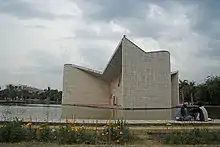Panjab University
Panjab University (PU) is a collegiate central university located in Chandigarh, India.[3] Originated in 1882 as the University of the Punjab Lahore, it was relocated in Chandigarh in the year 1947 as the East Punjab University after the partition of India, where the university was split between India and Pakistan.
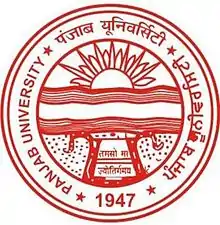 Seal of Panjab University | |
Motto in English | Lead us into the Light from Darkness |
|---|---|
| Type | Public |
| Established | 14 October 1882 |
| Chancellor | Vice-President of India |
| Vice-Chancellor | Raj Kumar[1] |
Academic staff | 997[2] |
| Students | 18,409[2] |
| Undergraduates | 9,932[2] |
| Postgraduates | 5,972[2] |
| 2,505[2] | |
| Location | Sector 14 and Sector 25 Chandigarh, India |
| Campus | Urban 550 acres (2.2 km2) |
| Colours | |
| Affiliations | UGC, NAAC, AIU, ACU |
| Website | puchd |
 | |
The university has 78 teaching and research departments and 10 centres/chairs for teaching and research at the main campus located at Chandigarh. It has 188 affiliated colleges spread over the eight districts of Punjab state and union-territory of Chandigarh, with Regional Centres at Muktsar, Ludhiana and Hoshiarpur cities in Punjab state.[4][5] It is one of the most well ranked universities in India.[6]
The campus is residential, spread over 550 acres (2.2 km2) in sector 14 and 25 of the city of Chandigarh. The main administrative and academic buildings are located in sector 14, beside a health centre, a sports complex, hostels and residential housing.[7]
History
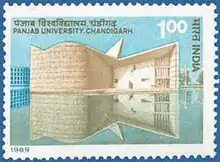
The present-day Panjab University traces its roots to the University of the Punjab established on 14 October 1882 at Lahore (now in Punjab, Pakistan). Most of the colleges affiliated to University of the Punjab were in the present Indian part of British India.
After the partition of India in 1947, the university was split into two for Indian Punjab and Pakistani Punjab. A new university was then established/relocated in the Punjab, India in 1947. To distinguish the two, the name of the university on the Indian side, the spelling for 'Punjab' was changed to Panjab. After 1947[8] the university had no campus of its own for nearly a decade. The administrative office was in Solan and the teaching departments functioned from Hoshiarpur, Jalandhar, Delhi, and Amritsar.
In 1956 the university was relocated to Chandigarh, on a red sandstone campus designed by Pierre Jeanneret under the guidance of Le Corbusier. Until the re-organisation of Punjab in 1966, the university had its regional centres at Rohtak, Shimla, Jalandhar and its affiliated colleges were in the states of Punjab, Haryana, Himachal Pradesh and U.T. of Chandigarh. With the re-organisation of Punjab, the university became an Inter-State Body Corporate catering to the newly organised state of Punjab and union-territory of Chandigarh.
Campus
The University's chequerboard layout, devised by Swiss-French Architect Pierre Jeanneret, was a role model for campus design in India.
The main campus at Chandigarh is spread over 550 acres in sectors 14 and 25, the teaching area is in the north-east, with the Central Library, Fine Arts Museum, and three-winged structure of the Gandhi Bhawan forming its core; the sports complex, the health centre, the dolphinarium, student centre and the shopping centre in the middle; 16 university hostel and residential area in the south-east, stretching into the adjacent sector 25 which also houses the University Institute of Engineering and Technology and Dr. Harvansh Singh Judge Institute of dental Sciences and Hospital, UIAMS, Institute of Biological sciences etc.
The campus has amenities like a State bank of India branch, Post and Sampark, public transport system, open-air theatre, guest and faculty houses, seminar complexes, staff club, several spacious lawns, botanical and medicinal herbs gardens, a newly laid rose garden, a school and a day-care centre for the employees' children. The campus is adjacent to a medical institution known as the Post Graduate Institute of Medical Education and Research.
Halls of residence
There are eighteen hostels on the campus including eight hostels for men and eleven women hostels including a Working Women Hostel. A Sports Hostel has been built for visiting sports teams. Two more hostels are under construction, one each for boys and girls. There is one International hostel also. All the NRI/Foreign national girls students are accommodated there.[9]
All the hostels have Wi-Fi internet and multiple messes for students. In addition to this,all the hostels have a common room and a visitor room. There are also shopping centres and ATMs for students and faculty on campus. The Dean, Student Welfare and the Dean Student Welfare (Women) look after the functioning of the university hostels, the conduct of election to the student bodies, planning and organising of cultural and extra-curricular activities on the Campus. They disburse cultural scholarships and financial assistance to campus students.
Health services
The University Health Centre offers consultancy, clinical and emergency services. There are five full-time doctors, including one medical specialist, one surgical specialist and one dental specialist. Part-time consultants include a gynaecologist, a paediatrician, a radiologist, an eye specialist, an Ayurvedic doctor and two general physicians. They are supported by a large paramedical staff.
Beside regular consultancy, medicines and emergency attention, employees and students have access to facilities like the clinical tests, ECG, X-Ray, ultrasonic treatment, diathermy and Yoga. The centre runs a Family Welfare Clinic with facilities of family planning, vaccination and immunisation of children (DPT, Polio and BCG). From time to time the Health Centre launches health awareness drives through lectures, film shows and workshops.
Sports
The University has playgrounds, a gymnasium and a swimming pool for its sports activities. The Directorate of Sports organises about 70 Inter-College and four to five Inter-University Competitions every year. The Directorate of Sports participates in 62 games both for men and women in the Inter-University Competitions and arranges training camps in these games under the supervision of expert coaches. The University has been awarded Maulana Abul Kalam Azad (MAKA) Trophy fifteen times, the latest being in the year 2020. MAKA Trophy represents the highest award given for inter-university sports and university sportsperson performance in international and national arena by the Government of India.[10]
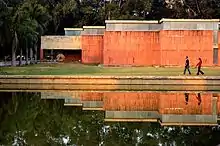
Gandhi Bhawan
The Gandhi Bhawan is a major landmark of the city of Chandigarh. Designed by the architect Pierre Jeanneret, a cousin of Le Corbusier, it is an auditorium hall that sits in the middle of a pond of water. Today it also houses a collection of books on Gandhi.
The Student Centre
The Student Centre, popularly known as StuC, is a major landmark of the city of Chandigarh and hub for student activities. It was inaugurated in 1975. It houses the office of the university students' council. There used to be a cafeteria called Indian Coffee House with a panoramic view on the top floor of the centre but now it has shut down its operations.[11] Besides this various events and plays are performed in the Student Centre.
Library
The Central Library is named after its late Vice-Chancellor of the University, Prof. A.C. Joshi.[12] It is located near the student centre.[13] It was designed by Swiss architect Pierre Jeanneret. The foundation stone of the Library was laid in 1958 by Dr. S. Radhakrishnan, the then Vice-President of India, and it was formally inaugurated in 1963 by the then Prime Minister of India Jawaharlal Nehru.[14] With a collection of 6,70,000 titles, it is one the largest library in North India.
Museums
The university has four museums, and the Department of Indian theatre has its own theatre lab. The university has a botanical garden and a garden of medicinal plants on the campus.
The Museum of Fine Arts
The Museum of Fine Arts houses the early works of almost all of the major artists of modern India. The collection was created through the initiative of the art historian B. N. Goswamy. Originally, the building was supposed to house the collection of archaeological artefacts that had been discovered by the Department of Ancient Indian History, Culture and Archaeology. Today the museum of AIHC&A is housed in a modern annexe adjacent to the Fine Arts Museum.
Organization and administration
Faculties
- Faculty of Engineering and Technology
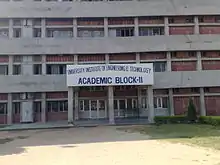
- University Institute of Engineering and Technology (UIET) is an on campus engineering institute. It offers undergraduate Bachelor of Engineering (BE), postgraduate Master of Technology (MTech) and doctoral courses.[15]
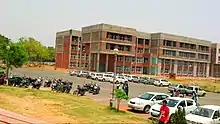
- Chandigarh College of Engineering and Technology (CCET) is a prestigious engineering & technology institute of Panjab University. It offers undergraduate (BE) and doctoral (Ph.D) courses. Chandigarh College of Engineering and Technology (CCET) is under the administrative control of the Chandigarh Administration. Chandigarh College of Engineering and Technology, Chandigarh(CCET), formerly known as Central Polytechnic Chandigarh (CPC), was established in 1959 (which offered Diploma Courses in Engineering).
- University Institute for Chemical Engineering and Technology (UICET), originally called the department of Chemical Engineering and Technology, UICET came out of a demand to make the sciences of direct use to society. The department was disrupted during the partition of India when most of the faculty and students chose to come to India. For a few years it was housed in Delhi. Then in 1958, it shifted to its present premises in Chandigarh. In collaboration with Illinois Institute of Technology, Chicago. Professor R. E. Peck from IIT Chicago joined as the first Head. Over the years the department evolved into the University Institute for Chemical Engineering and Technology. In 1983, an Energy Research Institute was added within the UICET building to promote R&D in the field of renewable energy.
UICET is one of the regional centres of the Indian Institute of Chemical Engineers. 2008 was the Golden Jubilee year of the institute. As part of the celebrations, the institute hosted CHEMCON-2008, the 61st annual session of the Indian Institute of Chemical Engineers, which also included a joint US-India Conference on Energy.
- Swami Sarvanand Giri Regional Centre (PUSSGRC)
PUSSGRC is an integral part of Panjab University acting as Regional Centre located at Hoshiarpur, started in 2006.
- Faculty of Law
The university has two departments for teaching law. The National Institutional Ranking Framework (NIRF) has ranked Faculty of Law, Panjab University 15 in the National Law Rankings 2020.[16]
- Department of Law offers two courses:
The department conducts a separate admission test, for both the courses, on the pattern of the Union Public Service Commission.
- The University Institute of Legal Studies was established as a separate department in 2004.
The institute offers B.A. LL.B (Hons.) and B.Com. LL.B (Hons.) five-years integrated courses, and has three hundred and sixty seats. This institute has been a partner institute for Surana & Surana National Trial Advocacy Moot Court Competition.
- Faculty of Business Management and Commerce
- University Institute of Applied Management Sciences was started in 2008 by the Faculty of Business Management & Commerce, PU, Chandigarh. It is housed in Panjab University-South Campus, Sector 25. UIAMS offers MBA course in industry ready sectoral areas and streams with specialization in functional areas like Marketing, Finance, Human Resources and Operations.[17] MBA at UIAMS Chandigarh is a two-year course.[18] Students are given training offers with stipend by various leading companies during the course.[19] UIAMS graduates tend to benefit from good job placements in major companies.[20][21][22][23]
- University Business School, Department of Commerce and Business Management imparts commerce and business management education to develop business tycoons and research specialists . The Department of Commerce and Business Management was rechristened into University Business School (UBS) in 1995. The department offers various courses such as Master of Commerce (Honours) , Doctor of Philosophy (Commerce and Business Management), Master of Business Administration (General), Master of Business Administration (Entrepreneurship), Master of Business Administration (Human Resource Management), Master of Business Administration (International Business) and Executive Master of Business Administration.[24]
- University Institute of Hotel and Tourism Management (UIHTM) - An institute of the Panjab University, offers education, training, research and consultancy in the field of hospitality, tourism, travel and allied sectors. This institute was established in the year 2009 under the faculty of Business Management and Commerce.
Constituent Colleges
- Baba Balraj Panjab University Constituent College, Balachaur (SBS Nagar)
- Panjab University Constituent College, Mokham Khan Wala (Ferozepur)
- Panjab University Constituent College, Nihalsingh Wala (Moga)
- Panjab University Constituent College, Dharamkot (Moga)
- Panjab University Constituent College, Sikhwala (Sri Muktsar Sahib)
- Saheed Udham Singh Panjab University Constituent College, Guru Har Sahai (Ferozpur)
Regional Centres
- Panjab University Regional Centre – Ludhiana
- Panjab University Regional Centre – Muktsar
- Panjab University Swami Sarvanand Giri Regional Centre, Hoshiarpur
- Panjab University Rural Centre Kauni
Academics
Departments and courses
The day-to-day functioning of the University is headed by Vice Chancellor Raj Kumar.[25] The office of Dean of University Instruction (DUI) is the academic head of Panjab University and its Regional Centres. 78 departments, 15 centres/chairs on the campus and six Constituent Colleges located at Sikhwala (Sri Muktsar Sahib), Balachaur (SBS Nagar), Nihalsingh Wala (Moga), Dharamkot (Moga), Mokham Khan Wala (Ferozepur) and Guru Harsahai (Ferozepur) and one rural regional centre. Three regional centres are grouped under the faculties of Arts, Science, Languages, Law, Education, Design and Fine Arts, Business Management and Commerce, Engineering and Technology, Hotel Management and Tourism, Medical Sciences, and Pharmaceutical Sciences.[26] There are also departments of Evening Studies and Distance Learning. Most departments have their own libraries.[27] The Faculty of Languages also has courses in foreign languages. The Department of Chinese and Tibetan languages runs 7 courses. One in Buddhist Studies and three each in Tibetan and Chin. beside providing research guidance in Buddhist Studies.
Rankings
| University rankings | |
|---|---|
| General – international | |
| QS (Asia) (2020)[28] | 291-300 |
| QS (BRICS) (2019)[29] | 195 |
| Times (World) (2020)[30] | 601-800 |
| Times (Asia) (2020)[31] | 149 |
| Times (Emerging) (2020)[32] | 166 |
| General – India | |
| NIRF (Overall) (2020)[33] | 44 |
| NIRF (Universities) (2020)[34] | 26 |
| The Week (Universities) (2019)[35] | 13 |
| Outlook India (Universities) (2020)[36] | 21 |
| Engineering – India | |
| NIRF (2020)[37] | 72 |
| Law – India | |
| NIRF (2020)[38] | 15 |
| Business/Management – India | |
| NIRF (2020)[39] | 42 |
| Pharmacy – India | |
| NIRF (2020)[40] | 2 |
| Dental – India | |
| NIRF (2020)[41] | 28 |
The QS World University Rankings rankings ranked it 291–300 in Asia in 2020[28] and 195 among BRICS nations in 2019.[29] It was ranked 601–800 in the world by the Times World University Rankings of 2020,[30] 149 in Asia[31] and 166 among Emerging Economies University Rankings in 2020.[32]
In India, the Atal Ranking of Institutions on Innovation Achievements by the Ministry of Human Resource Development has ranked Panjab University 10 overall in 2019.[42] The National Institutional Ranking Framework (NIRF) has ranked Panjab University 44th overall in 2020,[33] 26th among universities,[34] 72nd in the engineering ranking,[37] 42 in the management ranking[39] and second in India in the pharmacy ranking.[40]
Research
ICSSR
The Indian Council of Social Science Research has set up its North-Western Regional Centre on the campus. The centre runs a library, a seminar complex and a guest house for visiting scholars under its study-grants programme.
Institute of Social Science Education and Research
Institute of Social Science Education and Research (commonly known as ISSER or PU-ISSER) is a liberal arts institution and a constituent department of the Panjab University.[43] The institute offers a five-year integrated, honour-school Masters of Arts degree in the Social Sciences.
Research facilities
The university has been recognised by the UGC as the "University with Potential for Excellence in Bio-Medical Sciences" with facilities for Stem Cell Research and Drug Development.
The university is one of six centres in the country for super-computing facilities to serve the north-western region in Technology Information Forecasting and Assessment Council (TIFAC), DST. The government of India has identified the university as a Special Centre. The university provides internet connection for more than 1800 terminals for the use of faculty members and students. All the buildings of the University including hostels are connected through ATM and Gigabit technology.
The university has a DST supported Regional Sophisticated Instrumentation Centre along with a Central Instrumentation Laboratory (CIL) and a University Science Instrumentation Centre (USIC) to serve the scientific community on the campus and in the region. The Centre for Industry Institute Partnership Programme (CIIPP) promotes the academic-industry interface.
Energy Research Centre
The Energy Research Centre was established in 1983 at Panjab University to promote R&D and Extension activities in Renewable Energy. The Energy Research Centre is the only R&D centre in the country designated as a Nodal Agency for the implementation of the programmes of MNES.
The centre has been designated as a regional test centre for testing solar thermal equipment by MNES. The Bureau of Indian Standard has approved the centre for testing wood-burning stoves. The centre has provided consultancy to countries in the Asia-Pacific region such as the Maldives, Bangladesh, Sri Lanka, Myanmar, Kiribati and Tuvalu, in the area of renewable energy sources, energy management and environmental protection. The centre has helped the states of Haryana, Panjab and Himachal Pradesh in solving problems associated with energy planning, management and environmental protection.
The centre has done work on solar thermal energy storage, solar detoxification, biomethanation of agricultural/industrial/forest wastes, biomass combustion and gasification, indoor air quality, energy and environmental conservation and management, and hydrodynamics of polymeric solutions. The Energy Research Centre has professional contacts with universities such as the University of Florida, the University of Cincinnati, SRI International USA, and Lakehead University in Canada. The centre has helped the states of Haryana, Punjab and Himachal Pradesh, U.T. Chandigarh, J&K State, and the North-Eastern states in solving problems associated with energy planning and management and Environmental protection.
LHC project
The university has participated in the project called International Collaboration for Research for Elementary Particles and the Large Hadron Collider (LHC) CERN, Geneva CMS Experiment with a Government of India grant of Rs. 24.9 million.
Student life
Cultural events
"Cyanide" the annual festival of DCET/UICET, was one of the first student festivals started in Chandigarh and has a long tradition. The festival is often host to star performers, DJ nights and other events. Tatva is the student magazine of DCET/UICET. There is an annual debate competition called the Polemic. Aavishkar was the technical fest of UIET until 2013. At present,Goonj is the techno-cultural fest and Umang is the annual sports fest of UIET. Both the events are marked by a lot of enthusiasm and are also two of the most awaited events in India, especially for undergraduate students of engineering and technology.[44]
Panjab University is active on social media websites such as Facebook,[45] Twitter[46] and Instagram.[47]
Student council
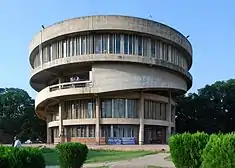
The office of the Panjab University Campus Students Council (PUCSC) is located in the student centre. The student centre is the hub of students' activities – academic, cultural, social and political – besides being a favourite eating and hanging out zone for students. The Students' Council consists of the departmental representatives and other office bearers i.e. President, Vice-President, Secretary and Joint-Secretary directly elected by the students from the various teaching departments on the campus. The Dean Student Welfare is ex officio Chairman of the council.
The Students' Council organises youth festivals, both national and international, academic debates, literary and cultural events and educational tours, besides looking after the interests of the students in general. In 2015, in a referendum by University, students voted for vehicle free campus in academic areas.[48][49]
Notable people
References
- "New Vice-Chancellor of Punjab University Professor Raj Kumar takes charge". The Indian Express. 24 July 2018. Retrieved 26 July 2018.
- "NIRF 2020" (PDF). Panjab University.
- "Chandigarh's Sector 14: A long way from Lahore". hindustan times. 11 July 2018. Retrieved 26 July 2018.
- Service, Tribune News (26 August 2015). "3,872 appear for LLB entrance at PU". The Tribune. Retrieved 26 August 2015.
- "Affiliated Colleges of PU". puchd.ac.in. Missing or empty
|url=(help) - Joshua, Anita (5 December 2013). "Panjab University overtakes IITs, JNU in ranking". The Hindu. ISSN 0971-751X. Retrieved 31 August 2019.
- Vibhor MohanVibhor Mohan, TNN (15 July 2013). "'Preserve Chandigarh's rich urban and architectural legacy'". The Times of India. Retrieved 26 August 2015.
- "UGC State Universities" (PDF). University Grants Commission. 27 May 2011. Archived from the original (PDF) on 15 May 2011. Retrieved 25 June 2011.
- http://hostels.puchd.ac.in/hostel-handbook-2019.pdf
- "List of winners of Maulana Abul Kalam Azad Trophy (1956-2018)" (PDF). Ministry of Youth Affairs and Sports (India). Retrieved 8 October 2020.
- "National Sports Awards -2019 announced" (Press release). Press Information Bureau, India. 20 August 2019. Retrieved 8 October 2020.
- "National Sports Awards 2020 announced" (Press release). Press Information Bureau, India. 21 August 2020. Retrieved 8 October 2020.
- https://indianexpress.com/article/education/punjab-universitys-indian-coffee-house-bids-farewell-5809998/
- "A C Joshi Library". Panjab University. Retrieved 14 June 2020.
- http://library.puchd.ac.in/
- "University Library". Panjab University.
- "University Institute of Engineering & Technology". uiet.puchd.ac.in. Archived from the original on 26 March 2012. Retrieved 24 June 2011.
- "MHRD, National Institute Ranking Framework (NIRF)". www.nirfindia.org. Retrieved 11 June 2020.
- "About - University Institute of Applied Management Sciences Panjab University Chandigarh India". uiams.puchd.ac.in. Retrieved 26 July 2018.
- Delhi, IndiaToday.in New (12 January 2016). "PU-MET 2016: Exam on March 12 : Notification". IndiaToday. Retrieved 26 November 2016.
- Miglani, Neha (2 November 2011). "Rise in training stipend for students". The Times of India. Retrieved 26 November 2016.
- TN, N (25 May 2011). "Placement cheer at UIAMS". The Times of India. Retrieved 26 November 2016.
- "Placements back to cheer students". The Tribune, Chandigarh, India. 31 March 2010. Retrieved 26 November 2016.
- "At Panjab University, four departments record maximum number of placements". The Indian Express. 15 February 2016. Retrieved 26 November 2016.
- Kachhava, Priyanka (29 September 2013). "Panjab University students hope to cash in on campus placements". The Times of India. Retrieved 26 November 2016.
- "Courses at UBS". Panjab University. Retrieved 27 June 2018.
- "PU is now my university, but he does not responsible enough to take the load of not being provided with the Original Marks cards to students through 1968-1973 of all residential departments of the said university. We students are left high and dry by this attitude. We want to know what does V-C Raj Kumar has to say to that". hindustan times. 24 July 2018. Retrieved 26 July 2018.
- "Deans and Secretaries of Faculties - Panjab University, Chandigarh, India". puchd.ac.in. Retrieved 26 July 2018.
- "Moolah beckons varsity students". Tribune News Service. 19 May 2018. Retrieved 26 July 2018.
- "QS Asia University Rankings 2020". QS Quacquarelli Symonds Limited. 2020.
- "QS BRICS University Rankings 2019". QS Quacquarelli Symonds Limited. 2018.
- "Top 1000 World University Rankings 2020". Times Higher Education. 2019.
- "Times Higher Education Asia University Rankings (2020)". Times Higher Education. 2020. Retrieved 4 June 2020.
- "Times Higher Education Emerging Economies University Rankings (2020)". Times Higher Education. 2020. Retrieved 13 March 2020.
- "National Institutional Ranking Framework 2020 (Overall)". National Institutional Ranking Framework. Ministry of Education. 11 June 2020.
- "National Institutional Ranking Framework 2020 (Universities)". National Institutional Ranking Framework. Ministry of Education. 11 June 2020.
- "The Week India University Rankings 2019". The Week. 18 May 2019. Retrieved 9 June 2020.
- "Top 75 Universities In India In 2020". The Outlook. 8 October 2020. Retrieved 8 October 2020.
- "National Institutional Ranking Framework 2020 (Engineering)". National Institutional Ranking Framework. Ministry of Education. 11 June 2020.
- "National Institutional Ranking Framework 2020 (Law)". National Institutional Ranking Framework. Ministry of Education. 11 June 2020.
- "National Institutional Ranking Framework 2020 (Management)". National Institutional Ranking Framework. Ministry of Education. 11 June 2020.
- "National Institutional Ranking Framework 2020 (Pharmacy)". National Institutional Ranking Framework. Ministry of Education. 11 June 2020.
- "National Institutional Ranking Framework 2020 (Dental)". National Institutional Ranking Framework. Ministry of Education. 11 June 2020.
- "ARIIA - Atal Ranking of Institutions on Innovation Achievements". www.ariia.gov.in. Retrieved 10 June 2020.
- "Institute of Social Science Education and Research Panjab University Chandigarh India". isser.puchd.ac.in. Retrieved 5 March 2019.
- "Cyanide - Let's Explode".
- "PU joins Facebook's Ivy League". The Tribune India. Retrieved 26 July 2018.
- "Panjab University (@OfficialPU) on Twitter". twitter.com. Retrieved 26 July 2018.
- "Panjab University strengthens its online reach with official Instagram account @officialpu.india". The Times of India. Retrieved 27 July 2018.
- Service, Tribune News (6 September 2015). "Ban(e) or boon?". The Tribune. Retrieved 6 September 2015.
- TNN (5 September 2015). "PU students vote out cars from campus". The Times of India. Retrieved 6 September 2015.
